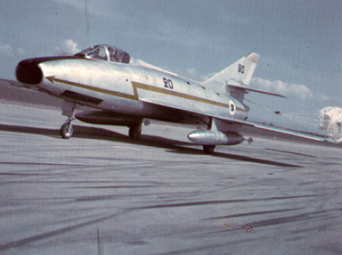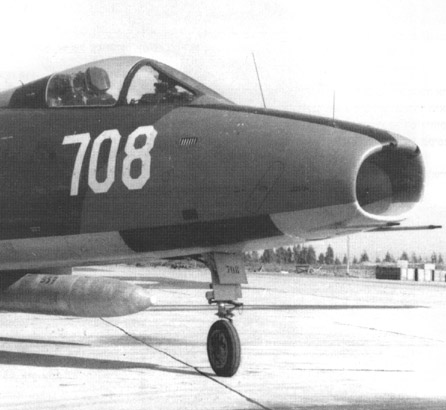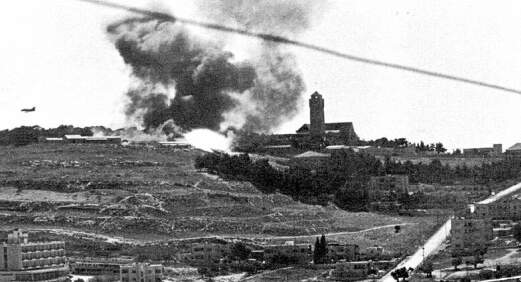


Skirmishes with the Egyptian air forces continued, meanwhile. On August 16th 1959 Egyptian MiG-17s attempted to disrupt an IAF Vautour exercise but departed by the time a Sambad pair had been scrambled to engage them. Another encounter over southern Israel took place on November 4th. One MiG was damaged in the exchange while the IAF lost a single Super Mystere after it had gone into a spin and its pilot, David Ivri (IAF Commander 1977 - 1982), was forced to eject. More encounters took place during 1960, one during February, one on May 26th and another on August 19th. A number of MiGs were damaged in these dogfights, but not a single one was downed, much to the disappointment of the Super Mystere pilots. Only after the arrival of the Dassault Mirage in 1962 was the cause of these failures discovered. Both aircraft were equipped with the same 30mm DEFA cannons whose rounds were set for delayed detonation, suitable against Soviet bombers for which they were developed, but ineffectual against jet fighters. The solution had come too late for the Super Mystere, by this time surpassed by the Mirage as the IAF's top interceptor. Only a single Super Mystere kill was achieved before the Six Days War, on April 28th 1961, when a MiG-17 attempting to evade a Super Mystere flown by Tzur Ben-Barak went into a spin and crashed.
While the 1960s saw a gradual cooling down of Israel's southern border with Egypt, things were warming up in the north, along the Syrian border. Syrian attempts to divert Israel's water sources on the Golan Heights
led to a series of clashes also known as the "War for the Water". Super Mysteres often took part in these exchanges and in the mid 1960s were given a blue & brown ground attack livery, replacing the silver livery of their interceptor days. When fighting flared up on March 17th 1963, Sambads were up in the air to bomb Syrian artillery and to counter any threat from the Syrian Air Force (SAF). On March 25th, four Sambads encountered 4 SAF MiG-17s but no aircraft were damaged in the dogfight that ensued. Fighting was renewed in November 1963 and on the 13th 5 Super Mysteres were launched against the Syrian position at Tel-Hamara. Only 2 eventually took part in the attack, one with napalm and the other with a pair of 250kg bombs. More strikes took place on April 7th 1967, after Syrian shelling of Israeli settlements.
The 18 aircraft originaly supplied to Israel were in April 1967 joined by a further batch of 24 ex-Armee de l'Air examples. The "Akrav" squadron, by now headed by Major Aaron Shavit, was by the outbreak of the Six Days War the largest squadron in the IAF, with 39 aircraft in its inventory. The 105th took a large part in operation "Moked", the opening move of the war, attacking Egyptian, Jordanian and Syrian air fields. During the operation's first attack wave, aimed at Egypt, the Super Mysteres were tasked with attacking the air fields at Abu-Sweir, Kabrit, Inchas, Faid and Mansurah. At Inchas, a Super Mystere was lost to anti aircraft fire while Shavit's aircraft was damaged and barely made it back to Hazor. Another Super Mystere quartet sent to attack Inchas, attacked Cairo-West by mistake. 4 Super Mysteres sent to attack Kabrit arrived in time to down an Ilyushin Il-14 on its landing run and also encountered Egyptian MiG-21s on their way back, but failed to shoot any down. By noon on June 5th 1967 Syria and Jordan had also entered the war, and operation "Moked" was widened to encopass their air bases as well. IAF Super Mysteres attacked the Syrian air fields at Saykal and Dumayr and the Jordanian field at Amman. Over Saykal the Sambads encountered a pair of Syrian MiG-21s and although outclassed by the MiGs, shot both of them down. By the end of the first day of hositilities, the 105th squadron had flown 128 sorties and had destroyed dozens of enemy aircraft on the ground and 5 aircraft in the air (its only kills throughout the war).
 Having disabled Arab air forces, the IAF next turned its attention to assisting Israel's ground offensive. In the Sinai, Super Mysteres attacked Egyptian armour, destroying tanks and artillery. Sambads also played a large part in the conquest of West Bank, attacking Jordanian armour threatening Israeli forces and artillery
bombarding Israel. On the morning of June 7th, Super Mysteres pounded the Jordanian Leagon's positions on Jerusalem's Augusta Victoria ridge, allowing Israeli paratroops to take it over nearly without a fight
(picture). Attacks also took place against Syrian fortifications on the Golan Heights, as well as against Syrian convoys on their way to the front. A Super Mystere pair took part in one of the most unfortunate
mistakes of the war, the attack on the USS Liberty, an American ship mistaken for an Egyptian supply ship. The 105th squadron had flown a total of 507 sorties during the war and had lost 9 aircraft. Two aircraft were lost on June 5th after attempting to evade Egyptian MiG-21s. Both crashed, killing both pilots. Another
was lost striking a Syrian base on the Golan Height, its pilot killed as well. 6 Super Mystere pilots were killed during the war, and another had fallen captive.
Having disabled Arab air forces, the IAF next turned its attention to assisting Israel's ground offensive. In the Sinai, Super Mysteres attacked Egyptian armour, destroying tanks and artillery. Sambads also played a large part in the conquest of West Bank, attacking Jordanian armour threatening Israeli forces and artillery
bombarding Israel. On the morning of June 7th, Super Mysteres pounded the Jordanian Leagon's positions on Jerusalem's Augusta Victoria ridge, allowing Israeli paratroops to take it over nearly without a fight
(picture). Attacks also took place against Syrian fortifications on the Golan Heights, as well as against Syrian convoys on their way to the front. A Super Mystere pair took part in one of the most unfortunate
mistakes of the war, the attack on the USS Liberty, an American ship mistaken for an Egyptian supply ship. The 105th squadron had flown a total of 507 sorties during the war and had lost 9 aircraft. Two aircraft were lost on June 5th after attempting to evade Egyptian MiG-21s. Both crashed, killing both pilots. Another
was lost striking a Syrian base on the Golan Height, its pilot killed as well. 6 Super Mystere pilots were killed during the war, and another had fallen captive.
The formal end of the Six Days War did not end the fighting between Israel and its nighbours. Super Mysteres were back in action on July 15th 1967, attacking Egyptian positions along the Suez Canal. 1968 saw a great
deal of fighting on the Jordanian front. On March 21st 1968 Super Mysteres pariticipated in operation "Tofet" (Inferno) against Palestinian terrorists in the Jordanian village of Karama, and on March 29th
attacked Jordanian artillery. Palestinian targets came under another attack on August 24th, while Jordanian positions were attacked on June 4th and November 7th. Foreign forces in Jordan were targeted as well. Syrians forces were attacked during August and on December 4th a Sambad was lost while striking at Iraqi forces, its pilot beaten to death by Jordanian troops. February 1969 saw strikes carried out against Egyptian troops on Shadwan Island in the Gulf of Suez, during which two Egyptian torpedo boats were sunk. When the IAF initiated operation "Boxer" against Egyptian missile sites on July 20th 1969, the Super Mysteres were once again pounding Egyptian military positions.
January 22nd 1970 saw a repeat of Sambad attacks against Shadwan Island, this time prior to a takeover by Israeli commandos brought there by IAF helicopters. January 1970 also saw large scale operations against Palestinian positions in Jordan and southern Lebanon.
Throughtout its service the Super Mystere had suffered from a weak and ineffectual engine. Furthermore, when France embargoed all weapon sales to Israel in 1968, following an Israeli commando raid on Beirut airport, the IAF faced the prospect of running out of spares. These two factors contributed to the decision made to replace the original Atar 101G-3 engine with the Pratt & Whitney J52-P-8A, already installed in IAF A-4 Skyhawks. The upgraded Super Mystere, the "Sa'ar" (Tempest), took off on its maiden flight on February 13th 1969. The 105th sqaudron begun receiving the Sa'ar in December 1969, and the new type continued to serve alongside the old Super Mysteres for three years. Once a month a Super Mystere would depart the squadron for Israel Aircraft Industries and then return a Sa'ar. The conversion of 26 examples was completed in early 1973, all available Sambads converted to Sa'ars.
 back to the IDF/AF page
back to the IDF/AF page